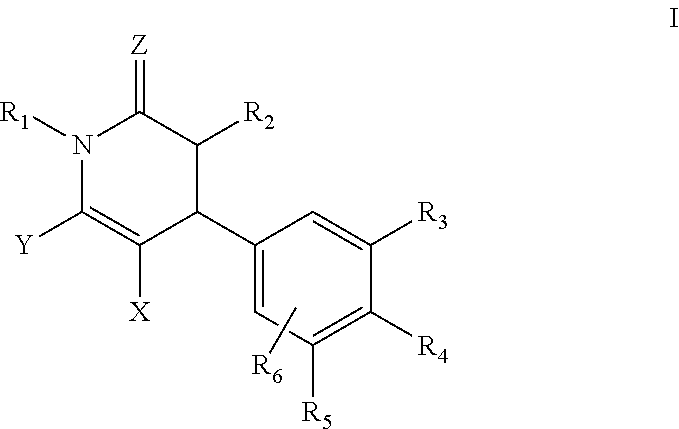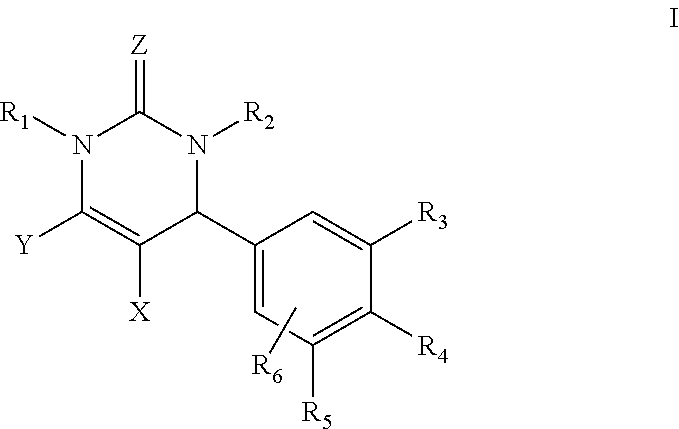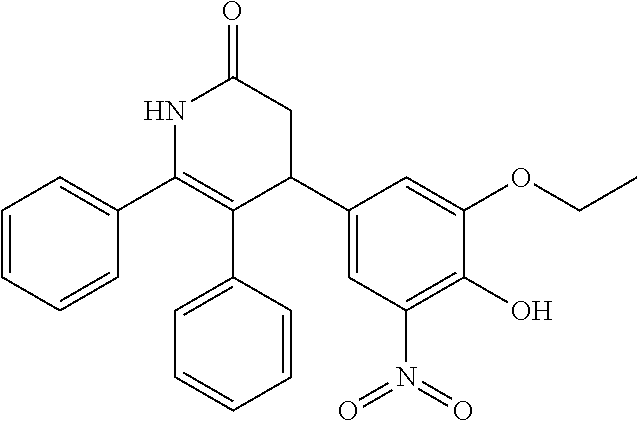Novel Dihydropyridin-2(1H)-One Compounds as S-Nitrosoglutathione Reductase Inhibitors and Neurokinin-3 Receptor Antagonists
a technology of s-nitrosoglutathione reductase and dihydropyridin, which is applied in the field of new dihydropyridin2 (1h)one compounds, can solve the problems of poor pharmacokinetics and pharmacodynamic properties of compounds, difficult development of new drugs, and weight gain, and achieves high affinity
- Summary
- Abstract
- Description
- Claims
- Application Information
AI Technical Summary
Benefits of technology
Problems solved by technology
Method used
Image
Examples
example 1
Compound 1,4-(3-ethoxy-4-hydroxy-5-nitrophenyl)-5,6-diphenyl-3,4-dihydropyridin-2(1H)-one
[0167]
[0168]A mixture of 1,2-diphenylethanone (150 mg, 0.76 mmol), 3-ethoxy-4-hydroxy-5-nitrobenzaldehyde (194 mg, 0.92 mmol), meldrum's acid (132 mg, 0.92 mmol) and ammonium acetate (71 mg, 0.92 mmol) in acetic acid (5 mL) was refluxed overnight. The solvent was removed under reduced pressure and the residue was purified by silica gel column chromatography (EtOAc:PE=2:1) and prep-HPLC (0.1% TFA as additive) to afford Compound 1 as yellow solid (40 mg, yield: 13%). 1H NMR (DMSO-d6 300 MHz): δ 10.20 (s, 1H), 9.60 (s, 1H), 7.47 (d, J=3.0 Hz, 1H), 7.24-7.18 (m, 6H), 7.01-6.96 (m, 3H), 6.79 (d, J=8.1 Hz, 2H), 4.06 (q, J=6.0 Hz, 2H), 3.96 (d, J=5.1 Hz, 1H), 3.14-3.07 (m, 2H), 1.31 (t, J=7.2 Hz, 3H); MS (ESI): m / z 430.9 [M+H+].
example 2
Compound 2,4-(3-ethoxy-4-hydroxy-5-nitrophenyl)-6-(pyridin-3-yl)-5-(thiophen-3-yl)-3,4-dihydropyridin-2(1H)-one
[0169]
[0170]A mixture of 1-(pyridin-3-yl)-2-(thiophen-3-yl)ethanone (Intermediate 1, see Example 18 for synthesic description of all intermediates) (230 mg, 1.1 mmol), 3-ethoxy-4-hydroxy-5-nitrobenzaldehyde (296 mg, 1.4 mmol), meldrum's acid (202 mg, 1.4 mmol) and AcONH4 (108 mg, 1.4 mmol) in AcOH (3 mL) was refluxed under N2 overnight. The mixture was concentrated under reduced pressure and the residue was purified by prep-HPLC (0.1% TFA as additive) to give Compound 2 (60 mg, 12%). 1H NMR (MeOD 400 MHz): δ 8.70 (d, J=5.2 Hz, 1H), 8.67 (s, 1H), 8.30 (d, J=8.0 Hz, 1H), 7.90-7.62 (m, 1H), 7.72-7.60 (m, 1H), 7.27-7.24 (m, 2H), 6.94-6.92 (m, 1H), 6.58 (d, J=4.8 Hz, 1H), 4.20-4.11 (m, 3H), 3.30-3.25 (m, 1H), 2.79-2.74 (dd, J=16.2, 3.2 Hz, 1H), 1.45 (t, J=6.8 Hz, 3H). MS (ESI): m / z 438.3 [M+1]+
example 3
Compound 3,4-(4-(2H-tetrazol-5-yl)phenyl)-5-phenyl-6-(pyridin-3-yl)-3,4-dihydropyridin-2(1H)-one
[0171]
[0172]A mixture of 2-phenyl-1-(pyridin-3-yl)ethanone (Intermediate 2) (100 mg, 0.50 mmol), 4-(2H-tetrazol-5-yl)benzaldehyde (500 mg), meldrum's acid (88 mg, 0.61 mmol) and NH4OAc (47 mg, 0.61 mmol) in AcOH (5 mL) was refluxed under N2 overnight. The mixture was concentrated under reduced pressure and purified by prep-HPLC (0.1% TFA as additive) to give Compound 3 (25 mg, yield 13%) as yellow solid. 1H NMR (CD3OD 400 MHz): δ 8.68-8.50 (m, 2H), 8.21-8.15 (m, 1H), 8.10-8.00 (m, 2H), 7.75-7.60 (m, 3H), 7.20-7.05 (m, 3H), 7.03-6.88 (m, 2H), 4.31-4.20 (m, 1H), 3.45-3.30 (m, 1H), 2.83-2.71 (m, 1H). MS (ESI): m / z 395.4 [M+1]+
PUM
| Property | Measurement | Unit |
|---|---|---|
| half life | aaaaa | aaaaa |
| temperature | aaaaa | aaaaa |
| temperature | aaaaa | aaaaa |
Abstract
Description
Claims
Application Information
 Login to View More
Login to View More - R&D
- Intellectual Property
- Life Sciences
- Materials
- Tech Scout
- Unparalleled Data Quality
- Higher Quality Content
- 60% Fewer Hallucinations
Browse by: Latest US Patents, China's latest patents, Technical Efficacy Thesaurus, Application Domain, Technology Topic, Popular Technical Reports.
© 2025 PatSnap. All rights reserved.Legal|Privacy policy|Modern Slavery Act Transparency Statement|Sitemap|About US| Contact US: help@patsnap.com



